Why the way we measure household waste might need to be trashed
By Jesse Neill
 ENVIRONMENT AND SUSTAINABILITY Several UniSA researchers were part of an international team that found issues in waste measurement and analysed how human consumption affects waste generation. Photo: Unsplash
ENVIRONMENT AND SUSTAINABILITY Several UniSA researchers were part of an international team that found issues in waste measurement and analysed how human consumption affects waste generation. Photo: UnsplashA consumer-driven society has led to huge amounts of global waste being generated in recent decades, resulting in the United Nations setting global targets to bring it back to a more manageable level.
Prevention, reduction, recycling and reuse strategies are all part of the solution, aided by a team of international researchers, including from the University of South Australia, who are analysing how human consumption affects waste generation.
UniSA PhD student He He – now a postdoctoral researcher at Imperial College London – is the lead author of a recent paper examining the role of indirect waste.
Along with his supervisors Professor of Environmental Mathematics John Boland and Adjunct UniSA STEM researcher Dr Christian Reynolds, He has revealed significant issues with the current measurements of waste generation.
He warns that paying attention to the waste that households directly produce (direct waste), rather than looking at the production necessary to provide the goods or services consumed (indirect waste), is a misleading measure of waste generation.
“The biggest issue is the ineffective measurement of different types of indirect waste,” He says.
“The total waste generated along the supply chain is about three times higher than what the households dispose of directly.”
Indirect waste from the industrial sector includes the manufacturing, mining, agriculture, fisheries, forestry, electricity, gas and water sectors. Goods, such as food, clothes and electronic devices made by the sector and consumed by the household, are the main source of indirect waste.
He says the researchers collected data from several household waste bins in South Australia over a period of three months to determine their direct and indirect waste footprint.
“We had some interesting findings and comparisons between working couples without children and retired couples without children,” He says.
“Although working couples are spending less time at home, we found they actually contributed more waste overall – through indirect waste – when compared with retired couples living at home. The research showed that working couples spent more time at the office, so consumed more food from restaurants and fast-food products, and that they also spent more money for their living, both of which increase indirect waste generation.”
Prof Boland says the research demonstrated that it is possible to analyse indirect waste generation and treatment arising from household consumption that is typically hidden within the Australian and economic waste data.
“Most of the waste in the Australian economy is generated in the supply chain rather than at the household level,” Prof Boland says.
“Therefore, we need to go beyond how we minimise waste across the supply chain and instead leap to stewardship of resources so that we aim for a truly circular economy.
“[Ideally] what would happen is that the waste from one process becomes the input for another process, or in the case of food waste in particular as an example, the waste gets turned into compost for making more food.”
He and Prof Boland say their research shows that technologies and policies published by the Australian government aimed at reducing waste generation should focus on the supply chain or upstream processes, in addition to onsite disposal. They suggest policy makers levy an extra fee for waste generation, in terms of household consumption, and that the next step would be to analyse the indirect energy consumption and greenhouse gas emissions from different types of household consumptions.
Quantification of indirect waste generation and treatment arising from Australian household consumption: A waste input-output analysis is published in the Journal of Cleaner Production.
The paper was co-authored by Dr Christian Reynolds, an Adjunct Research Fellow from UniSA STEM, Dr Michalis Hadjikakou from Deakin University, and Dr Nicholas Holyoak from Flinders University.




